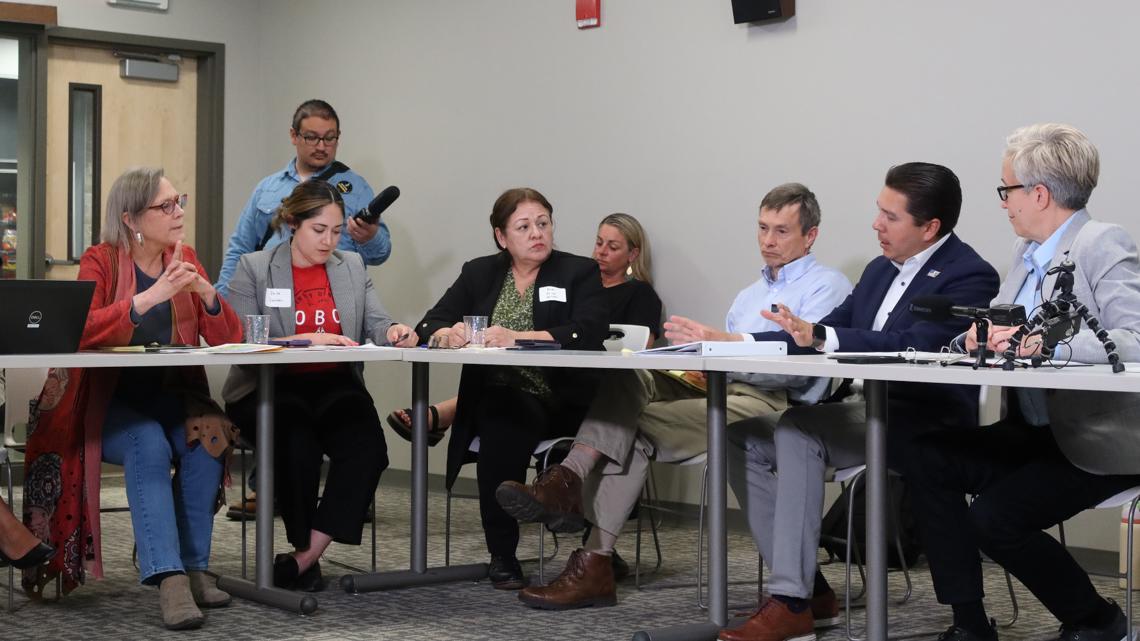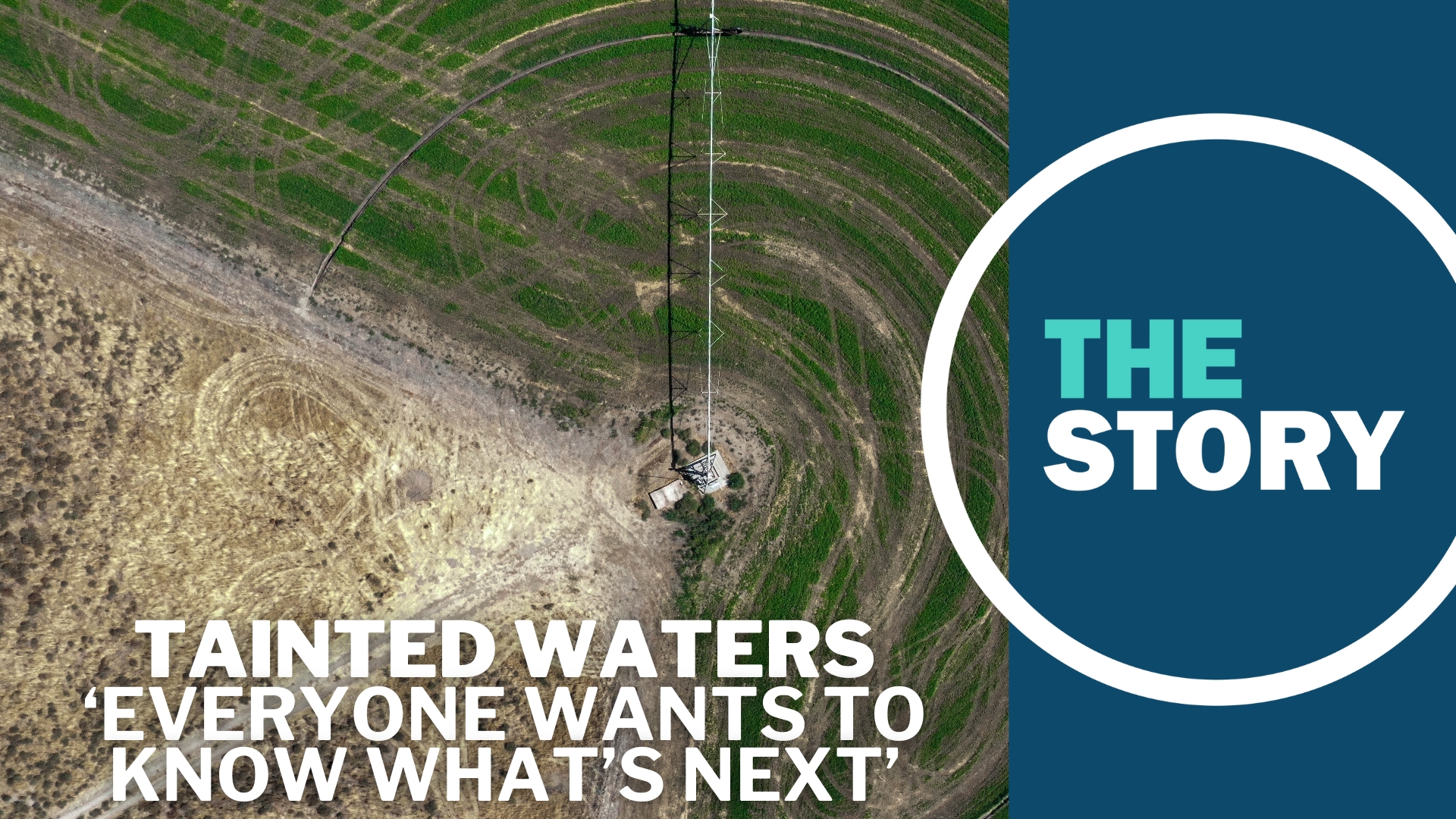BOARDMAN, Ore. —
It’s been more than 30 years since it was first learned that there were problems with toxic chemicals called nitrates seeping into the drinking water in Morrow and Umatilla counties.
And since then, the problem has only gotten worse.
On Wednesday, high-level officials from the state and federal governments — Gov. Tina Kotek and Casey Sixkiller, regional administrator for the U.S. Environmental Protection Agency — traveled to the region to hear how the state’s response has gone since a local public health emergency was declared in 2022.
“People are frustrated. People are scared,” Zaira Sanchez, director of community organizing for Oregon Rural Action, told Kotek and Sixkiller during one of two roundtable discussions at Blue Mountain Community College in Boardman.
For her part, Kotek acknowledged that while some progress had been made, there is plenty of room for improvement.
“I hear what you’re saying,” Kotek said. “We need to up our game.”
Part of the frustration stems from the long-running nature of the problem, which first came into focus in the 1990s.
Three decades and counting
In 1989, the state legislature passed the Oregon Groundwater Quality Protection Act, which mandated testing of groundwater. The first round of tests showed nitrate levels in Morrow and Umatilla counties above the state's threshold for safety.
A year later, the Oregon Department of Environmental Quality declared the region a Groundwater Management Area. It took four more years to produce a report identifying the sources of the contamination.
Nitrates come from a number of sources — fertilizer used in agriculture, animal feed lots, food processors and wastewater produced by the Port of Morrow and spread onto farm fields.
From there, the nitrates seeped into the aquifer, where thousands of residents outside of the Lower Umatilla Basin's cities use private wells to draw drinking water.
When ingested, nitrates can cause reproductive problems, respiratory issues and cancer; though tying any of those individual ailments directly to the groundwater has proven difficult.
Despite the problem being identified as early as the mid-'90s, little has been done to curtail the pollution or to protect rural communities south of the Columbia River.
In 2022, a regional public health emergency was declared, and officials began distributing clean water along with testing wells for nitrate contamination.
That long period of inaction was the backdrop to Wednesday’s discussions, where Kotek and Sixkiller first hosted more than a dozen representatives from community organizations and then sat down with county administrators.
‘We’re putting a band-aid on the problem’
Kotek and Sixkiller each traveled to the region around this time last year, so Wednesday’s meetings served as more of an update than an introduction.
“I was here literally a year ago meeting with some of you and really engaging,” Kotek said. “As I came in as a new governor, I heard about the challenges out here and we showed up, we learned, we listened and we’ve been getting to work.”
But when Kotek asked the community organizations in the room how things looked from their perspective, it was clear that work wasn’t necessarily translating to impacts on the ground, where some people remain unaware that their water may be unsafe.
“Unfortunately, over and over again we continue to find people that are not aware of the resources that are available, that there is a public health risk currently that we should be aware of, that continue to drink the contaminated water, that have been cooking with the water,” said Sanchez.
And that lack of information remains one of the biggest sticking points, at least in the short term.
“We need to treat this as an emergency, the emergency that it is, and that begins with making sure everyone is aware of the public health risk.” said Kristin Anderson Ostrom, executive director of Rural Action Oregon.
Of particular concern to Ana Piñeyro, of the Morrow County Health Department, was the slowing pace of action.
She said that in the six months after the emergency was declared, her team of 10 workers tested wells at more than 600 residences and installed more than 100 water treatment systems at people’s homes.
In the 18 months since, with the partnership of the Oregon Health Authority, roughly 1,800 wells have been tested, but only 76 treatment systems have been installed.
“How is it that with more time, more staff, more resources, we can accomplish less?” Piñeyro asked. “We need to make sure that we don’t forget, we’re doing this for the people and we should do it with the people.”
Sixkiller acknowledged that there was clearly more work to be done and said state agencies would be leaning on community organizations to help facilitate connections in the close-knit communities where they already have the trust of residents.


“We know we’re not going to be successful if we don’t do it in partnership,” Sixkiller said. "The knowledge that you bring, the networks that you have access to, is just mission-critical to moving this work forward.”
Still, even for those who are aware of the problem, many question how the process will unfold.
“For now, we’re putting a band-aid on the problem and providing them with water deliveries,” said Marisa Mendoza of the advocacy group Euvalcree, “but everyone wants to know what’s next.”
'We don’t want three more decades of pollutants’
The plans to help the people of Morrow and Umatilla counties will come in three forms, Kotek said: the near-term, the medium-term and the long-term.
In the near-term, both Kotek and Sixkiller reiterated their commitment to expanding testing and providing clean drinking water to those who need it.
At the same time, they both acknowledged the need to do a better job
“I hope everyone walks out of this room knowing that we’re in it,” Sixkiller told the community groups. “We’re going to continue to ask hard questions of each other.”
Beyond that, Kotek admitted there are some people whose wells may not be safe to drink from anytime soon.
“The next step for some communities where their wells are never going to be better, or at least for a long time, we have to get them on the public system,” she said.
That plan comes with several challenges of its own, though.
Annexing unincorporated parts of the counties into cities like Boardman or Hermiston, where municipal water systems exist, would mean that homeowners would have monthly water bills, would need to pay city taxes and would have to abide by zoning laws they might not agree with.
Roy Drago Jr., a Morrow County commissioner, told the governor that while extending public water systems to new customers was technically feasible, it won’t be easy.
“The big hurdle is getting the whole community to buy in,” Drago said. “I think we can navigate getting municipal water there, that’s fairly doable, but it’s going to cost a lot of money.”
In the long-term, Kotek said the goal is to eventually have an aquifer that’s free of toxic nitrates.
“When it comes to the root cause issue and the continued contamination, we have to alter how we’re doing business,” Kotek said. “We do need to say, 'We’re going to be doing this differently.' We don’t want three more decades of pollutants, right? That’s got to change.”
Kotek stopped short of endorsing mandatory regulations on polluters and said she preferred to try incentivizing polluters to cut down before imposing regulatory restrictions.
And the question of who pays for it all is a complicated one. Agriculture and the port are huge economic drivers in the region and employ many of the people whose water is now contaminated by their operations.
Striking a balance will be tricky, Kotek said. But one thing that can be done immediately is to increase transparency between state agencies and the community groups working on the ground, even if that means admitting when officials don’t have all the answers.
“There is value in going to the community and saying, 'We don’t know what the answer is, we don't know how much it's going to cost, but we want you to know that this is the process we’re going to follow,'” Sixkiller said.
For Ostrom, the executive director of Oregon Rural Action, the meeting was welcome, but the burden remains on the state to prove they’re serious about fixing the issues plaguing the region.
“The folks who live here and the people that we work with on a daily basis, when we say we’re coming to another meeting, they say ‘Oh, another dog and pony show,’” she said.
Only time will tell if Wednesday’s meetings were indeed just a show, or if real change is on the horizon.

